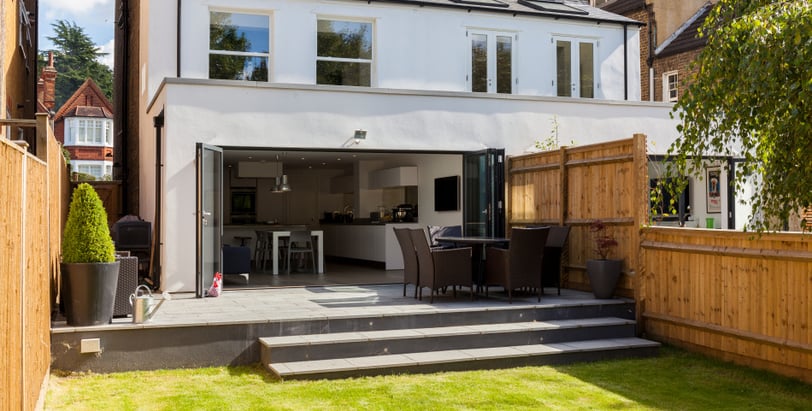Double Storey Extension UK 2025 – Cost, Ideas & Planning Guide
Discover how to design a double storey extension in the UK for 2025. Costs, planning permission rules, layout ideas, and must-know tips for your next big project.
7/3/20253 min read


Double Storey Extension UK – Your Complete 2025 Guide to Expanding Up and Out
With UK house prices remaining high and families needing more space, a double storey extension is one of the smartest ways to maximise living space without moving. Compared to a single storey, it can double your floor area for a relatively modest extra cost, making it popular for growing families and future-focused homeowners in 2025.
In this guide, you’ll find out exactly what a double storey extension involves, how much it costs in the UK today, design ideas, planning permission essentials, building regulation must-knows, and practical tips to get started.
What Is a Double Storey Extension?
A double storey extension (or two-storey extension) expands your home both horizontally and vertically—for example, by extending the kitchen and dining room on the ground floor and adding extra bedrooms, bathrooms, or an office directly above.
This means you gain twice the space without doubling your spend—because the same foundations, roofing, and walls serve two floors.
Why Choose a Double Storey Extension?
1. More Space for Growing Families
Add an open-plan kitchen-diner, utility room, or bigger lounge downstairs—then create new bedrooms, a master suite with en suite, or a dedicated home office above.
2. Cost-Effective Square Footage
A double storey extension costs only 30–50% more than a single storey, yet doubles the added area. Pound-for-pound, it’s excellent value.
3. Increases Property Value
Adding bedrooms and bathrooms is the best way to lift a home’s value. In popular UK areas, a high-quality two-storey extension can add 20–30% to your property’s market price.
4. Future-Proofing
Stay in your neighbourhood, avoid moving stress, and adapt your home for family life, hybrid work, or multi-generational living.
Popular Double Storey Extension Ideas
Here’s how homeowners are designing clever double storey extensions in 2025:
📐 1. Rear Double Storey Extension
The most common—extend out into the garden for a bigger kitchen-diner downstairs and new bedrooms upstairs.
🧱 2. Side Return & Double Storey Wraparound
Combine a side return with a rear extension and build two floors—perfect for Victorian terraces and semi-detached homes.
🛏️ 3. Over-Structure Extension
Build above an existing garage or single storey structure to add an extra bedroom or home office.
🚪 4. Open-Plan Living Below, Sanctuary Above
Design an open, light-filled kitchen and family space downstairs and a luxurious master suite with a Juliet balcony above.
🌿 5. Double Storey Extension with Loft Conversion
Some ambitious projects combine a two-storey extension with a loft conversion—transforming a small semi into a generous 5-bed family home.
Do You Need Planning Permission for a Double Storey Extension?
Yes, almost always. Unlike some single storey rear extensions that fall under Permitted Development (PD), double storey extensions usually exceed PD limits.
Key planning considerations in the UK:
They must not extend beyond the rear wall by more than 3 metres if within PD.
The extension must not be higher than the existing roof.
You must consider overlooking and overshadowing neighbours.
Side-facing windows must be obscure glazed.
Materials should be in keeping with the original house.
You’ll need Party Wall Agreements if you share walls with a neighbour.
Always consult your local planning authority or an experienced architect to prepare plans and navigate approvals.
Building Regulations for Double Storey Extensions
Even with planning permission, you must comply with Building Regulations for:
Structural integrity (foundations, walls, beams)
Load-bearing calculations (RSJs, steelwork)
Fire safety and escape routes
Drainage and plumbing
Insulation, ventilation, and energy efficiency
Staircases and headroom
Electrical and gas safety
A Building Control Officer or Approved Inspector will inspect the work at stages—from foundations to final sign-off—to issue your Completion Certificate.
How Much Does a Double Storey Extension Cost in the UK (2025)?
UK homeowners can expect:
£1,800–£2,800 per m² on average.
For a typical 30m² double storey extension: £55,000–£85,000.
High-end finishes or complex structural work: £100,000+.
Other costs:
Architect & structural engineer: £3,000–£8,000.
Planning permission fees: ~£250+.
Party Wall Agreements (if needed): £1,000+.
Interior fit-out: depends on kitchen, bathroom, flooring, and glazing.
Tip: Always keep a 10–15% contingency fund for unexpected expenses.
Tips for a Successful Double Storey Extension
✅ Work with a trusted architect or design-build firm.
✅ Talk to your neighbours early—they’ll appreciate it and it can ease approvals.
✅ Plan your garden access—don’t lose all outdoor space.
✅ Invest in big glazing for light-filled upstairs rooms.
✅ Choose sustainable insulation and heating to cut energy bills.
✅ Don’t forget the Party Wall Act if you share a boundary.
Final Thoughts
A double storey extension is one of the smartest ways to transform your UK home in 2025 — giving you the space you need for family life, hybrid working, or long-term investment without the cost and stress of moving.
By carefully planning your layout, understanding planning rules, and budgeting properly, you’ll enjoy a beautiful, functional, and future-proof home that adds real value and everyday comfort.